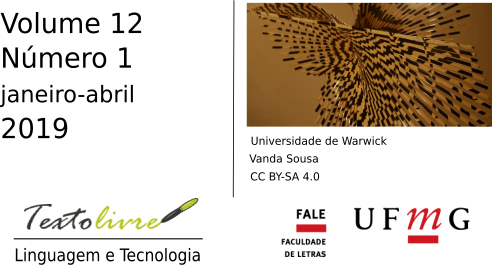As narrativas digitais interativas e transmídia e a sua aplicação na aprendizagem: o storytelling encontrou o CONSTRUIT e partiram em busca do SLIDE
DOI:
https://doi.org/10.17851/1983-3652.12.1.72-84Palavras-chave:
narrativas digitais, storytelling, modelo empírico, literacia.Resumo
RESUMO: Nos dias de hoje, o termo storytelling explode numa miríade de aceções. Para muitos, reporta ao contador de tempos ancestrais; para outros, pode ser a nova descoberta na área do marketing e da publicidade (MILLER, 2014) para outros, ainda, convoca à reflexão o conceito de narrativas digitais (JENKINS, 2001). Aqui consideramos o storytelling enquanto ferramenta de aprendizagem. Como esperamos demonstrar, ignorar o potencial das narrativas digitais como ferramenta de aprendizagem é, a limite, ignorar o potencial da linguagem como performativa da identidade. Para isso, convocámos a experiência da Modelagem Empírica (Empirical Modelling) que tem vindo a ser desenvolvida na Warwick University, Conventry com expressão na conferência CONSTRUIT 2017 e pretendemos demonstrar que a narrativa digital interativa transmídia pode, com sucesso, ser utilizada pela Modelagem Empírica (M.E.) na aprendizagem e literacia tecnológica dos seniores. Para tal, tomámos como referência, o projeto europeu SLIDE. A nossa premissa é que o ato comunicacional e as narrativas digitais sustentam, com sucesso, estes modelos de aprendizagem independendo da idade do aprendente.
PALAVRAS-CHAVE: narrativas digitais; storytelling; modelo empírico; literacia.
ABSTRACT: Nowadays, the term storytelling explodes in a myriad of meanings. For many, it reports to ancestral times; for others, maybe it is a new discovery in the field of marketing and advertising (MILLER, 2014). For others, yet, it implies the reflection under the concept of digital narratives (JENKINS, 2006). Here we consider storytelling as a learning tool. As we hope to demonstrate, ignoring the potential of digital narratives as a learning tool is, in the end, ignoring the potential of language as performative of identity. Being so, we have summoned the experience of Empirical Modeling (E.M.) developed at Warwick University, Conventry, namely, the outputs presented at the CONSTRUIT 2017 conference and we intend to demonstrate that interactive digital narrative transmigration can successfully be used by the Empirical Modeling (M.E.) in the learning and technological literacy of seniors. To this end, we have taken as a reference the European SLIDE project. Our premise is that the communicational act and the digital narratives are successful models of learning regardless of the age of the learner.
KEYWORDS: digital narratives; storytelling; empirical modeling; literacy.
Downloads
Referências
ARISTÓTELES. 2008. Poética. Lisboa: Fundação Calouste Gulbenkian. ASKWITH, I. & GRAY, J. 2008. “Transmedia Storytelling and Media Franchises”, in Robin Anderson & Jonathan Gray (Eds), Battleground the Media (pp. 519-528). United States of America: Greenwood Press.
BENVENISTE, E. 1966. Problèmes de linguistique générale. Paris: Gallimard.
BEYNON, M. 1999. “Empirical Modelling and the Foundations of Artificial Intelligence”. Department of Computer Science University of Warwick, UK.
BEYNON, M.; MCCARTY, W.; RUSS, S. 2005. In https://www.researchgate.net/publication/31458408_Human_Computing--Modelling_with_Meaning.
BUBER, M. 1982. Do diálogo e do dialógico. São Paulo, SP: Perspectiva.
CAMPBELL, J. 1997. The hero with a thousand faces. Princeton, Princeton University Press.
DELEUZE, G. & GUATTARI, F. (1987). A Thoushand Plateaus: Capitalism and Schizophrenia. Minneapolis: University of Minesota Press.
DENA, Christy. 2004. Current State of Cross Media Storytelling: Preliminary Observations for future design. Apresentado em Crossmedia communication in the dynamics knowledge society networking session em European Information Systems Technologies (IST) Event, 15 Novembro. Holanda: IST. p. 1-11.
ECO, U.1993. Leitura do Texto Literário: Lector in Fabula. Lisboa: Presença.
ESCALAS, J.; DELGADILLO, Y. .2004. "Narrative Word-Of-Mouth communication: Exploring memory and Attitude Effects of Consumer Storytelling", advances in Consumer Research Volume 31, pp: 186-192.
FINDEISEN, D. 2013. “Third_Age_University_Stereotypes_Prejudices_Old_Age_Discrimination- _Where_Do_We_Stand” in D. https://www.academia.edu/3894247/Dušana_Findeisen_Slovenian_Third_Age_University_Stereotypes_Prejudices_Old_Age_Discrimination-_Where_Do_We_Stand.
GENETTE, G. 1982. Palimpsests: La Litettérature au Second Degrée, Paris: Seuil. HUIZINGA, J. 1949. Homo Ludens - a study of the play-element in culture. London, Routledge & Kegan Paul.
JENKINS, H. (2006). Convergence Culture: Where Old and New Media Collide. Nova Iorque: New York University Press.
KINDER, M. 1991. Playing with Power in movies, television, and vídeo games. University of California Press. PP 5-277.
KRISTEVA, J. 1974. La Revolution du Language Poétique. L’Avantgarde à la Fin du Dixneuviéme Siècle: Lautréamont et Mallarmé. Paris: Seuil.
LYOTARD, J.P. 1989. A Condição Pós-Moderna. Lisboa: Gradiva.
MCLHUAN, M. 1993. Os Meios de Comunicação Como Extensões do Homem. São Paulo: Cultrix.
MEADOWS. 2003. Pause & Effect.The Arte of Interactive Narrative. USA: New Riders.
METZ, C. 1974. Film Language: A Semiotics of the Cinema. The University of Chicago Press.
MILLER, C.H. 2014. Digital Storytelling: A Creator's Guide to Interactive Entertainment. New York: Focal Press.
MURRAY, J. 2003. Hamlet no Holodeck: o futuro da narrativa no ciberespaço. São Paulo: Itaú Cultural-UNESP.
RICOEUR, P. 1976. Teoria da Interpretação: O Discurso e o Excesso de Significação. Edições 70, Lda. SOUSA, V. 2017. “Interactive transmedia vs. voronoi diagram expressions” EUROSIS ISBN 978-9077381-97-7 SCIFI-IT '2017 April - Bruges, Belgium.
TOFFLER, A. 1970. O Choque do Futuro. Lisboa: Livros do Brasil. VOGLER, C. 2007.
The writer’s journey: mythic structure for writers. Ann Arbor: Sheridan Books. Webgrafia dos projetos:
CONSTRUIT 2017 (https://warwick.ac.uk/fac/sci/dcs/research/em/construit/conference/programme)
SLIDE (https://www.facebook.com/pg/SLIDE-Storytelling-Learning-In-Digital-Europe389295324823558/about/)
Downloads
Publicado
Edição
Seção
Licença
Este é um artigo em acesso aberto que permite o uso irrestrito, a distribuição e reprodução em qualquer meio desde que o artigo original seja devidamente citado.











